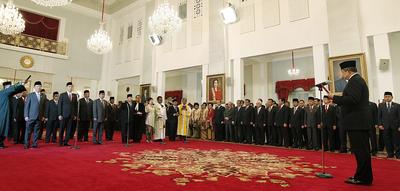The cabinet reshuffle was selective, and seemed to largely serve the coalition parties’ political interests. The strongest indication of this ‘transactional’ political flavour was the lack of courage shown by Yudhoyono in replacing party leaders who held ministerial positions. Suryadharma Ali, the Minister of Religious Affairs, whom the public viewed as a non-performing minister, kept his position, as did Minister of Labour and Transmigration Muhaimin Iskandar, whose department was recently hit by corruption scandals. Yudhoyono’s close allies were guaranteed to stay on as his ‘entourage’: Andi Mallarangeng, the Minister for Youth and Sports, kept his position despite his poor — if not shameful — performance in preparing for the upcoming Southeast Asian Games in November. Perhaps most controversial was the reshuffling of former Minister of Culture and Tourism Jero Wacik — an ally of Yudhoyono and a member of his Democrat Party — who, with no relevant expertise, was appointed as Minister of Energy and Mineral Resources. Meanwhile, Mari Elka Pangestu, former Trade Minister and a technocrat with international recognition, became the new Minister of Tourism and Creative Economy.
Hardly any ministers associated with political parties were reshuffled, except cabinet members of the Islamic Prosperous Justice Party (PKS), who were seen as playing off both the government and the opposition. And add to a veneer of seriousness, Yudhoyono added 10 new deputy ministers, bringing the total number to 19. But with the reshuffle based largely on transactional politics, Yudhoyono’s promises — to change leadership style, to have an effective government and to eradicate corruption — remain for many mere political rhetoric. For example, to convince the public of his dedication to combatting corruption, Yudhoyono stated during the new cabinet’s inauguration that the public funding had been ransacked and robbed, but as president, he should have investigated those involved and had them impeached. But this fighting language appears little more than empty rhetoric.
The challenges facing Yudhoyono’s administration cannot be overcome by the cabinet reshuffle alone; the issues he faces are far too complex. For one, the national government’s effectiveness is curtailed by the decentralised local governance system. Regulations produced by local parliaments often conflict with higher regulations and remain in place even while they should be withdrawn. And in around 60 per cent of the 524 Indonesian districts, the local government is hamstrung by conflicts between Mayors/Regents and their Vice Mayors/Regents. There are three reasons for this. First, district heads and their deputies often come from different political parties. Second, political and financial contributions by deputies are often bigger than those of the district heads. And third, the deputies’ scope of authority is not clearly delineated.
Many national and local regulations pertaining to development also overlap and conflict with each other. For example, regulation on national development conflicts with state budget regulations on fiscal transfers from central to local governments. And because government regulations are not cohesive or coherent, Yudhoyono’s administration will not to be able to make significant changes by only reshuffling the cabinet — if anything, the administration is likely to be slower and less capable of fulfilling public expectation. Furthermore, the new cabinet has no clear agenda or goal to work toward.
There is no shortcut to solving the problems that Yudhoyono’s administration currently faces. Instead, strong political will is needed from Yudhoyono to build consensus with coalition parties in order to issue clear national laws. Every regulation that is passed must have a clear purpose and align with existing regulation. But, instead of establishing a structure of power based on Indonesia’s reform priorities, the cabinet reshuffle was informed by political transactions. As a result, the Susilo Bambang Yudhoyono administration will worsen.
Maria Monica Wihardja is a Researcher at the Centre for Strategic and International Studies, Jakarta, and a Lecturer at the Department of Economics, University of Indonesia.
Josef Kristiadi is Senior Political Analyst at the Centre for Strategic and International Studies, Jakarta.


The authors of this post may have forgotten that SBY was in fact opposed to party leaders sitting in his cabinet when he first took office in 2004. He abandoned this sensible position, that could have become an enduring convention in Indonesia’s democracy, when Kalla took over as Golkar chair in December of that year, and SBY has never sought to reinstate it. The authors might also have pointed out that, even to achieve this virtually meaningless reshuffle, the president apparently needed a whole month of consultation and deliberation. Four weeks of speculation about who’s to stay and who’s to go doesn’t exactly maximise ministerial or bureaucratic efficiency. Who knows how long he would have needed to produce a worthwhile reshuffle?